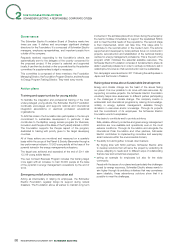APC 2011 Annual Report Download - page 79
Download and view the complete annual report
Please find page 79 of the 2011 APC annual report below. You can navigate through the pages in the report by either clicking on the pages listed below, or by using the keyword search tool below to find specific information within the annual report.
REGISTRATION DOCUMENT 2011 SCHNEIDER ELECTRIC 77
SUSTAINABLE DEVELOPMENT
2
COMMITTED TO AND ON BEHALF OFEMPLOYEES
•talent Pool to foster talent development throughout the world and
the access of women to key positions;
•recruitment policies, succession planning, access to training,
talent and promotion management, which pay particular attention
to gender balance and new economies representation;
•trainings leading to diplomas and qualifi cations for OATAM
employee categories (Manual Workers, Administrative
Employees, Technicians and Foremen), which impact is major
on promotion and remuneration of women, particularly manual
workers and assistants;
•working session trainings on diversity for members of the
Executive Committee and their management teams;
•On-line training program dedicated to the promotion of diversity,
launched globally in 2009.
Gender balance
In its diversity policy, Schneider Electric lays particular emphasis on
equal career management for men and women as the best means
to develop the values and skills required to meet the economic and
societal challenges of the 21st Century. Schneider Electric shares
the conviction that gender differences in the workplace (leadership
style and personality among others) complement each other, foster
innovation and provide a wealth of benefi ts to its customers.
From an operational point of view, the strategy consists of:
•promoting women in the talent pool and in positions of key
responsibility;
•ensuring equal access to training and developing the conditions
for genuine diversity in the workplace;
•curtailing average wage differentials by allocating a specifi c
annual budget (in France – see below);
•creating favourable working conditions for both men and women
by adopting measures designed to enhance work-life balance.
For example, succession planning for key positions in the company
must include at least one woman. Along the same line, the promotion
of women is monitored, as is their participation in leadership
development programs. “Go Green in the City” international case
challenge for students (see page73 ) is a Schneider Electric initiative
that helps attract female graduates for internship or recruitment.
Gender balance Executive Workshops (half day seminars focusing
on gender balance) were deployed in the leadership teams of main
entities. At end of 2011, 120 top managers have been involved.
In 2011, within the 2,500 talented employees identifi ed across the
Group, 25% are women ( up 4 points compared to 2010).
In the new company program, through 2012-2014, the percentages
of women in key positions and in the talent pool are key performance
indicators. The Planet & Society Barometer sets to have 30% of
women in the talent pool by the end of 2014.
Equal pay for women (France)
Salary equality is fundamental to the equality of treatment
that Schneider Electric is committed to guaranteeing for all its
employees, both male and female.
In France, this commitment has been put into action each year since
2006 by allocating a budget (0.1% of the salary total) dedicated to
reducing male/female salary inequality. In 2011, Schneider Electric
decided to strengthen this and launched a large campaign with two
objectives:
•to give meaning to the idea of “salary equity” even though salary
individualisation leads to differences in remuneration;
•to analyse all remuneration by looking at competencies,
responsibilities and the professional pathway of each male and
female employee.
Nationalities
Schneider Electric has always promoted change, adhering to an
international, innovative and responsible strategy. With 137,000
employees in more than 100 countries, Schneider Electric
transforms the diversity of its employees into a means to understand
its customers and the world in which we live.
In 2011:
•fi ve nationalities are represented within the Executive Committee
(French, American, German, British, Spanish);
•17% of Country Presidents are French, against 50% in 2003;
•20% of Country Presidents based in Asia are French, against
60% in 2003;
•the number of French expatriates is not currently more than 25%,
in 2003 it was 55%;
•the number of nationalities has increased considerably, from 48
in 2003 to 70 in 2011.
These developments are a result of the Group’s careful and
committed policy. In addition, Schneider Electric received the
Human Capital Award in 2011 within the Internationalisation of
Management category, from among the CAC 40 companies.
Emphasis is also placed on representation of new economies
with it in the Group’s talent pool: among the 2,500 high potential
employees identifi ed at the end of 2011, 36% are located within
the new economies (up 6 points compared to 2010). The share
of talent coming from the new economies is a key performance
indicator established in the new Business Program for the 2012-
2014 period.
Disability
Schneider Electric focuses on training and adapting workstations to
foster the independence of employees with a disability and to ensure
that all are accorded the same opportunities to succeed. Schneider
Electric is committed to ensuring maximum independence for
employees by adapting the organisation and workstations and
providing access to the best technologies available to compensate
for their disabilities. Schneider Electric also works on preventing
disabling situations.
All its teams cooperate to change behaviour, improve practices,
and involve all personnel in actively providing equal opportunities
for the disabled:
•the Recruitment and Mobility unit utilises partner fi rms and
monitors compliance with equal treatment at all stages of the
recruitment process;
•the Occupational Health Department is responsible for
preventing individual and group disabling situations (ergonomics,
desktop adaptation, musculoskeletal risks…), retaining disabled
employees and disability compensation;
•the Purchasing Department specifi es its requirements to
temporary employment agencies and ensures compliance
with commitments in terms of subcontracting to the protected
employment sector.
























